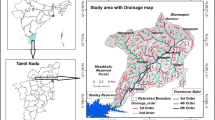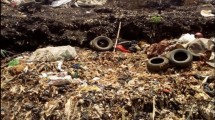Abstract
Assessment of groundwater potential and aquifer protection capacity is essential in proffering solution to groundwater exploration challenges and contaminants invasion into the aquifers. In this study, 3D resistivity model of one hundred and forty-three (143) VES data acquired along a grid layout was generated. The VES data were processed and interpreted quantitatively to obtain geo-electric parameters and longitudinal conductance. The geo-electric parameters, longitudinal conductance values and georeferenced geographic coordinates were gridded using 3D gridding algorithm to generate resistivity and longitudinal conductance distribution model for the study area. The 3D resistivity models were presented as resistivity distribution models, slices, and depth maps. The result reveals variable resistivity ranges from 50 to 2800 Ωm, and an observable low resistivity values (30–160 Ωm) occupying larger part of the study area. The northeastern portion of the distribution model shows an anomalous high resistivity range between 1000 and 2000 Ωm. The variation in resistivity distribution could be ascribed to the heterogeneity of basement complex rocks. The resistivity model further reveals low fracturing intensity across the area, and a low to moderate groundwater prospect. The longitudinal conductance distribution model classified the area into poorly protected zone (43%), moderately protected zone (50%) and excellent protective zones (7%). Thus, 3D subsurface resistivity model of 1D sounding data has proven to be suitable for groundwater potentiality mapping and overburden protective capacity assessment in basement terrain.










Similar content being viewed by others
References
Adeyemo IA, Omosuyi GO, Ojo BT, Adekunle A (2017) Groundwater potential evaluation of a typical basement complex environment using GRT index—a case study of Ipinsa-Okeodu Area, Akure. J Geosci Environ Prot Sci Res 5(3):240–251
Atakpo EA, Ayolabi EA (2009) Evaluation of aquifer vulnerability and the protective capacity in some oil producing communities of western Niger Delta. J Environ 29:310–317
Bayewu OO, Oloruntola MO, Mosuro GO, Laniyan TA, Ariyo SO, Fatoba JO (2018) Assessment of groundwater prospect and aquifer protective capacity using resistivity method in Olabisi Onabanjo University campus, Ago-Iwoye, Southwestern Nigeria. NRIAG J Astron Geophys 7(2):347–360. https://doi.org/10.1016/j.nrjag.2018.05.002 (ISSN 2090-9977)
Bayode S, Ojo JS, Olorunfemi MO (2007) Geophysical exploration for groundwater in Ejigbo and its environs, Southwestern Nigeria. Global J Geol Sci 5(1):41–49
Burke KC, Dewey FJ (1972) Orogeny in Africa in Afr Geol Ibadan. Ibadan Univ Press, pp 583–608
Carter R, Chilton J, Danert K. Olschewski A (2014) Siting of drilled water wells—a guide for project managers, rural water supply network (RWSN), St Gallen, Switzerland
Chegbeleh LP, Akudago JN, Makoto E, Samuel N (2009) Electromagnetic geophysical survey for groundwater exploration in the voltaian of Northern Ghana. J Environ Hydrol 17:1–16
Egbinola CN, Olaniran HD, Amanambu AC (2017) Flood management in cities of developing countries: the example of Ibadan Nigeria. J Flood Risk Manag 10(2017):546–554
Fashae OA, Tijani MN, Talabi AO (2014) Delineation of groundwater potential zones in the crystalline basement terrain of SW-Nigeria: an integrated GIS and remote sensing approach. Appl Water Sci 4:19–38. https://doi.org/10.1007/s13201-013-0127-9
Foster SSD, Hirata RCA, Gomes D, Eli D (2002) Groundwater quality protection. A Guide for Water Service Companies, Municipal Authorities and Environment Agencies 002. World Bank, Washington https://doi.org/10.1596/0-8213-4951-1
Ghouili N, Jarraya-Horriche F, Hamzaoui-Azaza F, FaouziZaghrarni M, Ribeiro L, Zammouri N (2021) Groundwater vulnerability mapping using the Susceptibility Index (SI) method: Case study of Takelsa aquifer, Northeastern Tunisia. J Afr Earth Sci 173:104035
Gogu R, Dassargues A (2000) Current trends and future challenges in groundwater vulnerability assessment using overlay and index methods. Environ Geol 39:549–559. https://doi.org/10.1007/s002540050466
Hasan M, Shang Y, Akhter G, Jin W (2018) Geophysical assessment of groundwater potential: 317 a case study from Mian Channu Area, Pakistan. Groundwater 56:783–796. https://doi.org/10.1111/gwat.12617
Herbst M, Hardelauf H, Harms R, Vanderborght J, Vereecken H (2005) Pesticide fate at regional scale: development of an integrated model approach and application. Phys Chem Earth Parts A/b/c 30(8–10):542–549
Khemiri S, Khemiri KS, A. Khnissi BA, Alaya S, Saidi F, Zargrouni, (2013) Using GIS for the comparison of intrinsic parameter methods assessment of groundwater vulnerability to pollution in scenarios of semi-arid climate. The case of foussana groundwater in the central of Tunisia. J Water Resour Prot 2013:835–845
Maillet R (1947) The fundamental equations of electrical prospecting. Geophysics 12:527–556
McLay CDA, Dragte R, Sparlin G, Selvarajah N (2001) Predicting groundwater nitrate concentrations in a region of mixed Agricultural land use: A comparison of three approaches. Environ Pollut 115:191–204
National Research Council (1993) Ground Water Vulnerability Assessment: Predicting Relative Contamination Potential Under Conditions of Uncertainty. Washington, DC: The National Academies Press. https://doi.org/10.17226/2050
Oladapo MI, Mohammed MZ, Adeoye OO, Adetola BA (2004) Geoelectrical nvestigation of the Ondo state housing corporation estate Ijapo Akure, Southwestern Nigeria. J Min Geol 40(1):41–48
Olorunfemi MO, Fasuyi SA (1993) Aquifer types and the geoelectric/hydrogeologic characteristics of part of central basement terrain of Nigeria (Niger State). J Afr Earth Sci 16:309–317. https://doi.org/10.1016/0899-5362(93)90051
Omosuyi GO (2010) Geo-electric assessment of groundwater prospect and vulnerability of overburden aquifers at Idanre Southwestern Nigeria. Ozean J Appl Sci. 3(1):19–28
Oni TE, Omosuyi GO, Akinlalu AA (2017) Groundwater vulnerability assessment using hydrogeologic and geo-electric layer susceptibility indexing at Igbara Oke, Southwestern Nigeria. NRIAG J Astron Geophys 6:452–458
Osinowo OO, Olayinka AI (2012) Very low frequency electromagnetic (VLF-EM) and Electrical resistivity (ER) investigation for groundwater potential evaluation in a Complex geological terrain around the Ijebu-Ode transition zone, southwestern Nigeria. J Geophys Eng 9(4):374–396. https://doi.org/10.1088/1742-2132/9/4/374
Osinowo OO, Falufosi MO (2018) 3D Electrical resistivity imaging (ERI) for subsurface evaluation in pre-engineering construction site investigation. NRIAG J Astron Geophys 7:309–317
Osinowo OO, Arowoogun KI (2021) A multi-criteria decision analysis for groundwater potential evaluation in parts of Ibadan, southwestern Nigeria. Appl Water Sci 10:228. https://doi.org/10.1007/s13201-020-01311-2
Pellerin L (2002) Applications of electrical and electromagnetic methods for environmental and geotechnical investigations. Surv Geophys 23:101–132
Rahaman MA (1976) A review of the basement geology of Southwestern Nigeria. In: Kogbe CA (ed) Geology of Nigeria. Elizabethan Publishing Co., pp 41–48
Rao NS (2006) Groundwater potential index in a crystalline terrain using remote sensing data. Environ Geol 50:1067–1076
Thirumalaivasan D, Karmegam M, Venugopal K (2003) AHP-DRASTIC: software for specific aquifer vulnerability assessment using DRASTIC model and GIS. Environ Model Softw 18(7):645–656. https://doi.org/10.1016/S1364-8152(03)00051-3 (ISSN 1364-8152)
Todd DK (2004) Ground water hydrology. Wiley, New York
Udosen NI (2021) Geo-electrical modeling of leachate contamination at a major waste disposal site in south-eastern Nigeria. Model Earth Syst Environ. https://doi.org/10.1007/s40808-021-01120-9
Wada Y, Van Beek PH, Van KC, Reckman WT, Bierkens MF (2010) Global depletion of groundwater resources. Geophys Res Lett
Zohdy AAR, Eaton GP, Mabey DR (1974) Application of surface geophysics to groundwater investigations: techniques of water resources investigation of the United Geophysical Survey Book. United States Government Printing Office, Washington, pp 42–55
Funding
This study was funded by the authors and did not enjoy funding either as grant or aid from any funding agent.
Author information
Authors and Affiliations
Corresponding author
Ethics declarations
Conflict of interest
There is no conflict of interest.
Compliance with ethical standards
This study was carried out in compliance with ethical standard, no violation of ethical standard.
Non-ethical approval
Not applicable.
Additional information
Publisher's Note
Springer Nature remains neutral with regard to jurisdictional claims in published maps and institutional affiliations.
Rights and permissions
About this article
Cite this article
Arowoogun, K.I., Osinowo, O.O. 3D resistivity model of 1D vertical electrical sounding (VES) data for groundwater potential and aquifer protective capacity assessment: a case study. Model. Earth Syst. Environ. 8, 2615–2626 (2022). https://doi.org/10.1007/s40808-021-01254-w
Received:
Accepted:
Published:
Issue Date:
DOI: https://doi.org/10.1007/s40808-021-01254-w




